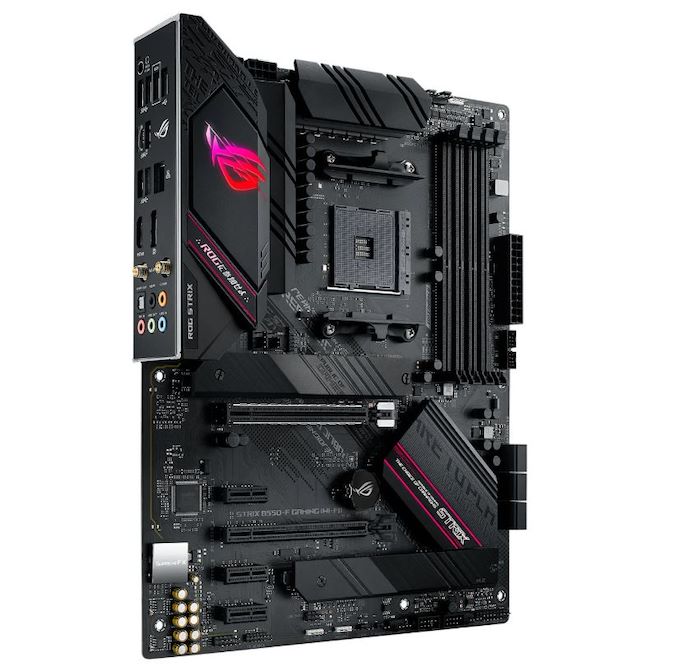The ASUS ROG Strix B550-F Gaming Wi-Fi Motherboard Review: Premium Value
by Gavin Bonshor on July 22, 2020 9:00 AM EST- Posted in
- Motherboards
- AMD
- Asus
- ROG
- AM4
- Strix
- Ryzen 3000
- Ryzen 3700X
- B550
- B550-F
ASUS ROG Strix B550-F Gaming Wi-Fi Conclusion
When AMD and motherboard vendors finally unveiled the B550 chipset, any potential conversational points were almost completely masked by discussions on the price. When a new B series chipset, that used to play in that $70-$200 region comes out *starting* at $165 and going beyond $300+, what else is there to talk about?? When delving deeper into the B550 product stack, as we did in our extensive B550 motherboard overview, it was clear that the majority of the models in the $200-300 price point are aimed at users that want or need premium audio and networking controllers. This is what ASUS has done with ROG Strix B550-F Gaming Wi-Fi, and it comes across as a polished example of a cost effective B550 motherboard,
Aimed at the mid-range, ASUS has equipped the Strix B550-F Gaming Wi-Fi with two M.2 slots, one with support for PCIe 4.0 x4 and one locked down to PCIe 3.0 x4. All of the boards PCIe 4.0 comes directly from the CPU, including the top full-length PCIe 4.0 x16 slot. The rest of the PCIe is driven by the B550 chipset which uses PCIe 3.0 lanes, including an additional full-length PCIe 3.0 x4 slot and three PCIe 3.0 x1 slots. One of the improvements over B450 is integrated support for USB 3.2 G2, in which ASUS has included two ports on the rear panel including a Type-C and Type-A.
Other interesting features include an Intel I225-V 2.5 GbE Ethernet controller and an Intel AX200 Wi-Fi 6 CNVi module which is generally found on more expensive X570 models; this is something which is becoming more mainstream in this price segment. It also includes a SupremeFX S1200A HD audio codec with a pair of amps which powers the onboard audio, and the codec itself does include EMI isolation which is a nice touch. The overall design is also interesting as it includes an all-black design with pink highlights on the rear panel cover and the chipset heatsink, which is very unconventional, but it blends in nicely and looks unique. Users looking to add more style can do so via three RGB headers, two regular and one addressable.
In our testing, the ASUS ROG Strix B550-F Gaming performed brilliantly in our system tests with the quickest POST time from any AM4 board we've tested with our Ryzen 3700X so far. The B550-F Gaming also had an impressive DPC latency result, with a massive advantage over other boards we've tested at default settings. In our CPU and game testing, the B550-F Gaming Wi-Fi was competitive. Our overclocking testing showed good results and tight VDroop control, with solid VRM thermals too. To put it mildly, the B550-F Gaming Wi-Fi has better VRM thermals than some X570 models costing double the price, which is a big win for ASUS here.

ASUS ROG Strix B550-F Gaming: Recommended
For $210 with Wi-Fi, or $190 without, ASUS provides a lot of quality and performance for the money. It puts to bed the expectation that B550 motherboards can't be as good quality as the X570 series models. Despite users expecting cheaper prices of B550, vendors look to have made improvements to the quality of the PCB to make sure the PCIe 4.0 implementation is optimal. There are lower cost B550 options available, but ASUS has a firecracker in the B550-F Gaming Wi-Fi and provides a solid alternative to X570.











40 Comments
View All Comments
Drweejah - Friday, April 16, 2021 - link
The Intel I225-V is trash. I had to add a nic to get internet.DZor - Wednesday, July 22, 2020 - link
In November I bought Gigabyte x570 Ultra and 3900X and now I plan to buy something for my son for gaming. I'm not happy with Gigabyte despite high grades. My biggest problem with Gigabyte is, as today usually, software. Better to say crappy software. For example every BIOS update deletes previous settings and usually I'm not able to load previous ones - every time remember what I did and set all manually! Oh my God! Not even Windows BIOS update is not clever enough to migrate BIOS settings. Their Windows software is one of biggest craps I ever seen in my life!!!How is situation with Asus and others?
BTW Gigabyte has a crappy software called Easy Tune. When I "overclocked" my CPU via this app my Windows refused to boot! Thanks God I have second installation and was able to delete exes to get Windows booting.
obiwancelery - Wednesday, July 22, 2020 - link
I've got bad news for you. I upgrade my BIOSs as soon as they're out. I have a Ryzen 5 2400G on a Asus TUF B450M-PLUS GAMING (great combination). I found it nifty I could store the settings so one day I flash my BIOS and then get my optimal settings. Black screen. As far as I can see, the settings are useless from one version of the BIOS to the other. Bummer. From what I can see, it's a new "trend". If anyone knows how to get this to work I'd love to know. I'm about to adjust the memory timings ... many, many settings to change. Upgrading the bios will suck.DZor - Thursday, July 23, 2020 - link
Thanks!You see that's reason why 20 years ago I switched from self-built PC to brand names like HP or Dell. I had many HPs, Dells and Lenovos with many BIOS updates and NEVER EVER entered BIOS after upgrade!
Avalon - Wednesday, July 22, 2020 - link
"The usual battleground for a good solid motherboard is in the $200 range" - No, it's not, and we need to stop perpetuating this. A good, solid motherboard needs to be in the $130-$150 range. If your board is coming with RGB lightning, has 16+ phases for power delivery, and looks like one of the Transformers, you've gone beyond "good".PeterCollier - Wednesday, July 22, 2020 - link
You forgot the "military grade" capsReflex - Wednesday, July 22, 2020 - link
I mean, 10-15 years ago that was the range of good solid motherboards. But inflation, reduced volume/slower upgrade cycle and higher base requirements (for signaling, power delivery, etc) would be expected to drive prices up. What we see now is essentially the same as what we saw before once factoring in inflation and market conditions.RGB lighting and additional power delivery phases are like dimes in the cost. And most of the R&D is shared with higher end boards. I think it just costs more to make a board now.
Oxford Guy - Saturday, August 1, 2020 - link
Inflation plus AMD wants to improve its margins. And, now that AMD is offering better CPUs than Intel, motherboard makers want more margin on AMD boards.Plus, Zen/AM4 has more demanding board specs than AM3+, in terms of things like voltage precision.
Board makers will try to push prices higher. It's up to consumers to push back.
CardiWAP - Tuesday, August 11, 2020 - link
Yes please pair your 10700K or 3900X with these boards and see how they fare. I hear Asrock really nailed the $130-$150 range on Z490.Reflex - Wednesday, July 22, 2020 - link
Not sure if this would help anyone, but the Asus and ASRock boards can actually get their WiFi upgraded. I realized that because I have a ROG Strix B350-I and the integrated Realtek WiFi/BT solution is garbage.It seems the 'integrated' solution is actually a vertically mounted M.2 card. If you take the shield off (two screws on the underside of the board) you can pull that card out and put in an AX200 (not the 201, that is specific to Intel chipsets).
I did the upgrade and it worked perfectly. BT is now reliable and WiFi is faster.
Not sure if that would help anyone.